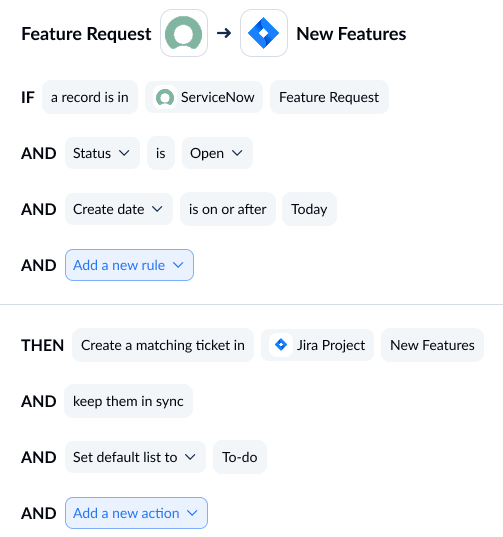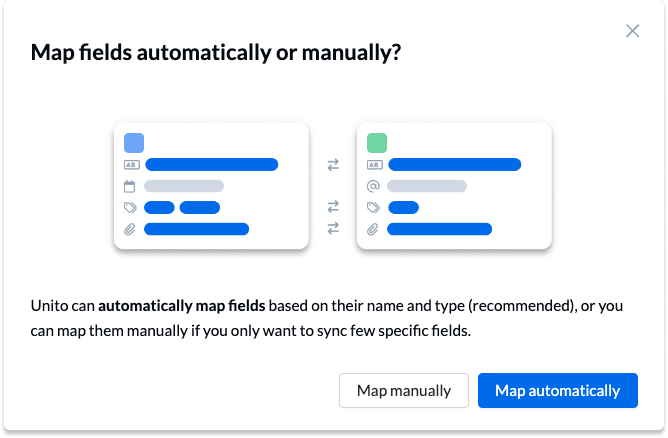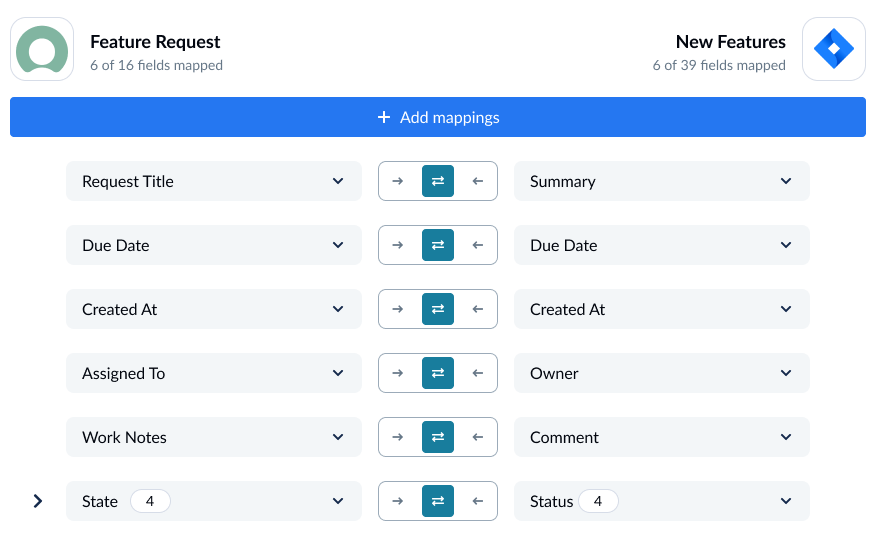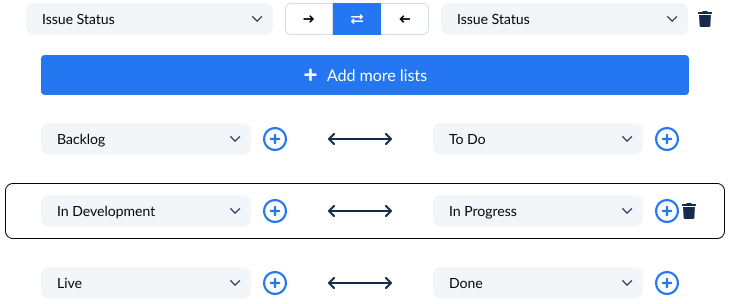How To Integrate ServiceNow and Jira With Two-Way Updates
This guide will teach you how to set up an integration to sync ServiceNow records with Jira issues using an automated 2-way flow from Unito. Since Unito is a completely customizable platform with a no-code interface, you can deploy your first integration without an IT team. You also won’t have to troubleshoot complete automations or work with expensive consultants.
More of a visual learner? Check out this video tutorial for syncing ServiceNow and Jira.
By the end of this guide your ServiceNow-Jira integration will:
- Create new Jira issues automatically based on ServiceNow records you create.
- Create new ServiceNow records synced with the Jira issues you work on.
- Update fields in real-time as you work in both tools.

In this guide:
- Tools: ServiceNow and Jira
- Use cases: Ticket escalation, product management, software development
- Great for: Product managers, IT, customer success, software developers, project management
Before you sync
You need to connect a ServiceNow account with CRUD rights (create, read, update, and delete) for the records and tables you plan on syncing to Unito. If you’re not sure how to do this, contact your ServiceNow admin for guidance.
Connecting ServiceNow to Unito for the first time
A ServiceNow admin needs to set up the initial connection between Unito and your ServiceNow account. From there, you can authorize Unito to sync data out of ServiceNow using OAuth 2.0 or a username and password.

Make sure you have the following information on hand to connect your account:
- ServiceNow Domain URL: https://INSTANCENAME.service-now.com
- OAuth 2.0: An OAuth Client ID and Secret
- Username: Your ServiceNow username and password
Setup in Jira
If you’re connecting Jira to Unito via OAuth2, then simply follow the on-screen instructions when adding your account for the first time:

If you’re not using OAuth 2 to connect to your Jira Cloud workspace, you’ll need to do the following:
- Set your Jira contact email visibility to anyone in your Jira profile page.
- Set up an application link in Jira to sync your issues to ServiceNow.
If you’re connecting an on-premise Jira Server instance to Unito, you’ll need to follow this guide. You can also use ngrok to connect Jira Server to Unito.
Step 1: Connect ServiceNow and Jira to Unito
- Sign up for Unito.
- Click +Create Flow in the Unito app.
- Click Start Here to connect ServiceNow and Jira.
- Click +Choose account for each tool and complete the authorization process.
- Choose the type of ServiceNow record you want to include in your flow. Unito supports all record types, including requests and incidents.
- Choose the ServiceNow table and Jira project you want to sync.
- Once that’s done, click Confirm.

First time connecting tools to Unito? Check out our in-depth guide.
Step 2: Choose flow direction
With flow direction, you determine where Unito automatically creates work items to match those you create manually. You have three options:
- 2-way: Both ServiceNow records and Jira issues are automatically created by your Unito flow to match the items your team creates manually in each tool.
- 1-way from ServiceNow to Jira: Jira issues will be automatically created by Unito to match ServiceNow records you create manually. Unito won’t create new ServiceNow records.
- 1-way from Jira to ServiceNow: ServiceNow records will be automatically created by Unito to match Jira issues you create manually. Unito won’t create new Jira issues.

Here’s a more detailed guide to how flow direction works.
Step 3: Build rules to sync specific work items
Unito rules can do two things:
- Filter out work items you don’t want to sync. For example, you could create a rule that only syncs records set as High priority.
- Automating certain actions. For example, you could create a rule that automatically assigns new Jira issues to a specific user.
To start building your rule, click Add a new rule, then choose a trigger and action.

You can learn more about setting rules here.
Step 4: Map fields between ServiceNow and Jira
When you map fields, you pair fields in ServiceNow with fields in Jira so data always goes right where it needs to be. Unito can usually map most fields automatically, whether they’re exactly the same (Assignee→Assignee) or compatible (URL→Text). You can also choose to map fields manually to fully customize your flow.

Here’s what you’ll see when Unito maps your fields automatically.

To add a new field mapping, click +Add mapping then Select a field. When you choose the field you want to map in one tool, Unito will automatically recommend compatible fields in a dropdown under the other tool.
Fields identified with a cog icon can be customized further once they’re mapped. For example, a Status field can be customized so its options match those in another field.

Step 5: Launch your ServiceNow-Jira integration
That’s it! You’re ready to launch your flow. Unito will automatically keep ServiceNow records and Jira issues in sync. This will allow your teams to collaborate more effectively without copying and pasting data or jumping back and forth between tools.
Ready to optimize your workflow?
Meet with our team to see what Unito can do for your workflows.
What’s next?
Need to integrate ServiceNow or HubSpot with other tools in your stack? Check out our other guides:


